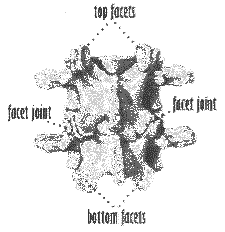From time to time, the National Scoliosis Foundation receives queries
from readers about how to manage pain in the spine. The pain is
not caused by scoliosis, but rather can be due to problems such
as facet joint syndrome. To find out more about this condition and
the remedies available, we asked our Medical Update editor, Nancy
Schommer, to contact Dr. James Hill, a neuroradiologist who specializes
in brain and spine imaging and pain intervention at New England
Baptist Hospital in Boston. What follows is an excerpt from their
conversation.
Q: Dr. Hill, what is facet syndrome?
A: Facet syndrome is characterized by back pain, with or without
tenderness, which can radiate from the back down to the buttocks
and into the thighs. The pain is caused by inflammation of the synovial
lining of the facet joints-the joints that connect the posterior
elements of one vertebral level to the next and which allow the
spinal column to bend forward and backward.

Q: Who is most likely to be affected by facet syndrome?
A: Facet syndrome can occur in people who have scoliosis, and in
those who do not. Generally speaking, it occurs in those individuals
who have some abnormal stress on the facet joints caused by disc
degeneration, osteoarthritis, or an abnormal curvature. We also
see facet syndrome in individuals who have had a fusion of the spine;
in these cases, the fusion causes extra stress on the joints above
and below it leading to inflammation and pain.
Q: If a person suspects he or she has facet syndrome, what steps
should be taken?
A: If you have a neurologist or orthopedist, see them first. Otherwise
see your primary care physician. Your doctor will probably perform
a physical exam and ask about your pain and where it's located.
The doctor may also request magnetic resonance imaging (MRI) to
see if there is any abnormal disc herniation that could account
for the pain.
Q: What can a physician do to alleviate the pain of facet syndrome?
A: An oral anti-inflammatory may give relief. If this fails, or
is contra indicated then a facet block is used. For this treatment
we inject steroids into the joint to relieve the inflammation of
the synovium that lines the joint.
Q: Would you describe the procedure?
A: After reviewing the procedure with the patient, he or she lies
prone on the examining table. The back is sterilized with betadyne
and then numbed with a local anesthetic. Using xray monitoring to
see the joints in real time, we then place a small spinal needle
into the joints that the referring clinician believes are affected
and inject them with steroids.
Q: What kind of steroid are you injecting into the joints?
A: It's called DepoMedrol. It's an oil-based steroid that remains
in the joints for two to three weeks while slowly being absorbed
by the blood stream.
Q: What happens next?
A: After the injection-which takes about 5 minutes-we pull the needle
just outside the joint and inject a local anesthetic over the capsule
of the joint. We do this to reduce achiness that can occur after
the injection; the numbing effect lasts for about 4-5 hours. After
the numbness wears off, the patient will probably experience two
days of mild to moderate achiness. Following that, it can take up
to two weeks for the steroids to attain their full anti-inflammatory
response.
Q: How successful is the facet block for reducing pain?
A: It's variable. About 80% of our patients get good to excellent
relief. Of those who do get relief, it usually lasts for months;
and on rare occasions it can last for years.
Q: You mentioned that one may have a facet block three times
a year but no more than that. Why not?
A: The risks of having excessive steroid injections are multifold,
ranging from osteoporosis to a hormonal condition known as Cushing's
syndrome. If the patient is diabetic, it will raise blood sugar.
And if you're already taking steroids for other reasons, the facet
block will add that much more steroid to your system.
Q: What if the patient is still in pain after three injections?
A: If pain is significant we will do another injection, but only
after warning the patient of the possible downside of excessive
steroids. At this point, the patient should see their physician
to determine if other forms of treatment such as spinal surgery
may be indicated.
Back to Medical Updates